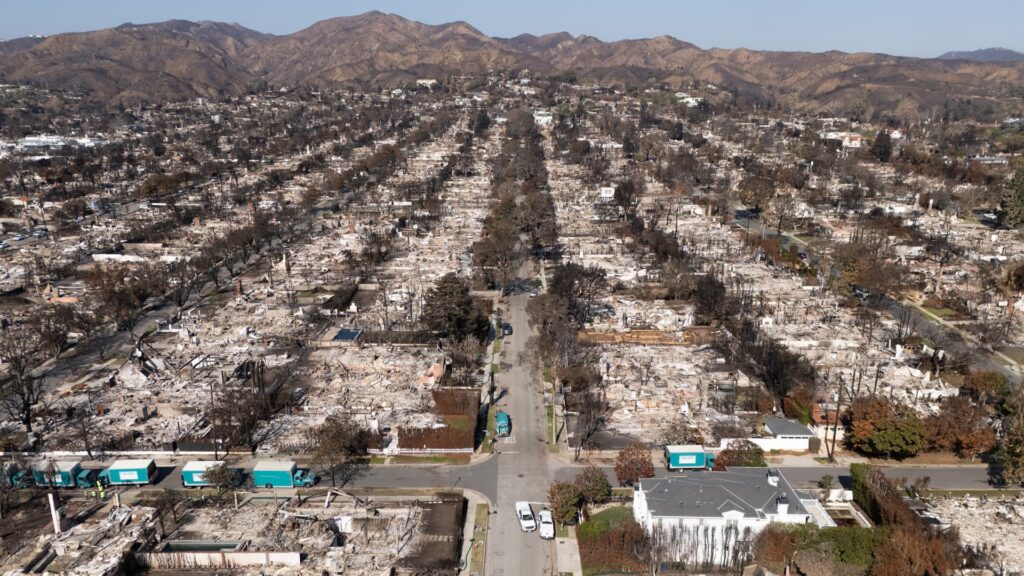California Wildfire Aftermath: Rising Insurance Rates Amid Recovery
Six months post-wildfires, California’s landscapes—particularly in areas like Altadena and Pacific Palisades—continue to bear the scars of devastation. With 30 lives lost and thousands of homes and businesses destroyed, the recovery process is ongoing, marked by alternating scenes of desolation and renewal.
Signs of Recovery
Amid the charred remains, flickers of hope emerge:
- Home Repairs: Homeowners are actively cleaning their lots and repairing properties that sustained damage.
- New Constructions: Some are successfully navigating complex permitting processes and acquiring necessary insurance to rebuild their homes.
Scott Wilk, an independent insurance agent in Santa Clarita, California, remarked, “The situation in insurance has actually been remarkably stable, considering everything that happened.”
Rising Insurance Premiums
Despite signs of recovery, insurance premiums are climbing sharply. According to Insurify, California premiums are projected to rise by 21% this year. This includes areas far removed from the wildfire zone, contradicting earlier predictions of modest increases statewide.
Factors Influencing Premium Increases
- High Payouts: Following significant disaster claims, insurance companies often find themselves paying out more than they earn in premiums. Chase Gardner, data insights manager at Insurify, notes that this trend forces companies to raise rates.
- National Ripple Effects: Premium increases are not confined to California. Insurify forecasts average premium hikes of 8% in all 50 states this year, with Louisiana experiencing the steepest rise at 28%. Even states like Iowa and Minnesota face double-digit increases.
Broader Implications
Benjamin Keys, a professor at the Wharton School, emphasized that this isn’t just a localized issue. “We’re seeing states with rising costs related to recent floods and climate-induced challenges,” he said. States like Colorado are witnessing similar trends, reinforcing that this is a nationwide concern rather than solely based on coastal or wildfire-prone areas.
Regulatory Landscape and Market Dynamics
Insurance premiums are regulated at the state level, meaning one state’s disaster cannot directly mandate rate increases in another. However, national insurance companies may adjust their pricing strategies based on their overall performance across states, affecting their decisions on policy renewals.
Variability of Premiums by State
- Florida: Highest average premium at $15,460.
- California: Projected average premium of $2,930, still below the national average of $3,520.
- Vermont: The lowest average at $1,248, even after recent increases.
Impact on Home Ownership
With increasing home insurance costs, Gardner pointed out, “Home insurance is becoming a bigger chunk of people’s monthly housing payments.” This trend complicates homeownership, especially in high-risk states like Florida, California, and Texas.
Future Projections
Experts anticipate continuing increases in premiums due to:
- Severe Weather Events: As natural disasters escalate, so do associated costs.
- Rising Replacement Costs: Higher home values and building expenses contribute to inflated premiums.
While Scott Wilk acknowledges that much of California’s crisis may be behind, he warns of more “sticker shock” waiting in the wings.
Significant Rate Hikes
- State Farm’s Moves: After dropping thousands of California policyholders, State Farm has secured approval for a 17% emergency rate increase and is seeking a further 13%.
Exploring Insurance Options
Despite soaring rates, some affordable options remain available from smaller carriers and "non-admitted" insurers operating independently of state regulators. Many homeowners express relief when their policies are renewed without cancellation—a stark contrast to past complaints over minor rate hikes.
Conclusion
The aftermath of California’s wildfires highlights critical challenges in the insurance landscape. As communities rebuild, understanding emerging trends in insurance rates becomes essential for homeowners navigating this complex environment. For more information on insurance rates or to explore options, visit Insurify for up-to-date resources and insights.


